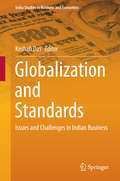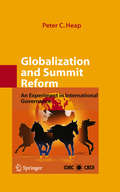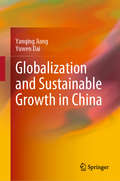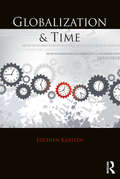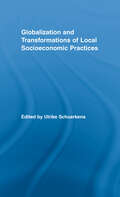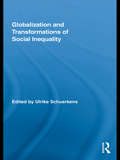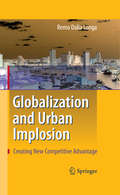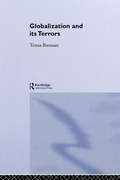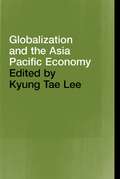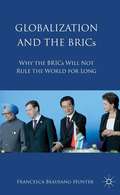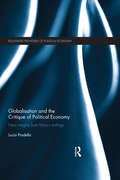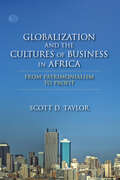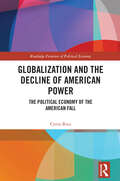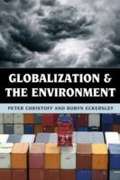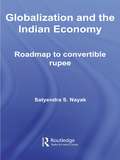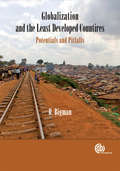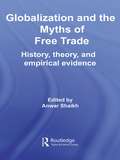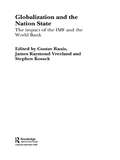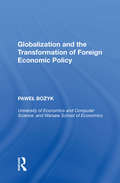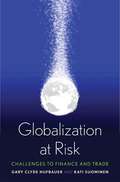- Table View
- List View
Globalization and Standards
by Keshab DasThe changes following more than two decades of economic reforms and globalization of the Indian economy - at state, corporate sector, and consumer level - raise interesting questions on the ways in which the stakeholders will continue to engage on the world stage, politically, socially and economically. One key feature of global trade over this period has been the growing importance of not only product standards but, importantly, labor, environmental, food safety and social standards. Being essentially a non-tariff barrier,standards have often become critical to market access and essential to sustained competitiveness. This has a clear impact on the manner in which both global and Indian business is conducted now and in the future. It also underlines the need for a new area of enquiry that addresses the following questions: How are the Indian public and private actors - the state, domestic firms, local consumers and society - influencing and being influenced by such standards? Do standards really matter in an overwhelmingly informal production sphere, with consumers deeply segmented on the basis of a highly skewed distribution of income and with the rural population becoming further marginalized? We have limited knowledge about the challenges faced and strategies pursued by these key domestic actors, both public and private. How have they been able to drive these processes and what are their implications for larger concerns with inequalities and the conditions of the poor? How does the omnipresent informality influence compliance, encourage multiple standards and affect the chances of addressing institutional dysfunctionality? What role does regulation play? These are some of the issues dealt with in the book, which has chapters focusing on aspects of specific sectors such as microfinance, pharmaceuticals, automobiles, tea trading, the role of the state and changing consumer influence. We have limited knowledge about the challenges faced and strategies pursued by these key domestic actors, both public and private. How have been they able to drive these processes and what are the consequences of these changes for the Indian economy, other emergent economies and for the rest of the developing world? In particular, what are their implications for the wider Indian society, especially on concerns with informality, inequalities and the conditions of the poor? How does informality in its omnipresent form influence compliance, encourage multiple standards and chances of addressing institutional dysfunctionality? What role does regulation play? These are some of the issues dealt within the book wherein chapters focus on aspects of specific sectors, trading, role of the state and changing influence of the consumer.
Globalization and Summit Reform
by P. Martin G. Smith Peter C. HeapThis account of the 'L-20 project' describes and analyses a 3-year mobilization designed as an alternative to the political deadlocks preventing progress on critical global issues. The book traces the origins and findings of the project, and addresses such hot button issues as global warming, poverty, and war in the developing world. The book features a Foreword by Dr. Gordon Smith, and an Afterword by the Right Honourable Paul Martin, former Prime Minister of Canada.
Globalization and Sustainable Growth in China
by Yanqing Jiang Yuwen DaiThis book is on globalization and sustainable growth in China. Thanks to the market-oriented policy reforms initiated in the late 1970s, China has achieved spectacular economic growth over the past several decades, and its economic structure has experienced great transformation. In the meantime, in the general context of globalization, the whole country has also gradually opened up to foreign trade and foreign direct investment, transforming itself from a virtually completely closed economy to a major trading nation and the largest developing-country destination for foreign direct investment in the world. In the first three chapters of this book, we investigate the potential and actual mechanisms and channels through which globalization, especially openness to foreign trade and foreign direct investment, affects industrial development and growth disparities in China. The current wave of globalization has encouraged economic growth in the world economy and affected all sides of international economic involvement. In the next four chapters of the book, we study China and the world economy. We first join the line of research on the trade frictions between China and the United States, including an analytical chapter on trade imbalance and protectionist policy, and an empirical chapter on business cycle synchronization between China and the US. A chapter on growth cycles in the BRICS is also included to explore growth and trade linkages among these five emerging market economies. A new “conventional wisdom” on globalization is that trade and financial openness do not lead to higher economic growth by themselves, in the absence of institutional reforms. Motivated by the Chinese experience, we develop an analytical framework in the last chapter to examine the case of growth targeting in China and draw policy implication for LDCs on how to achieve positive and sustainable economic growth. This book provides the readers with new facts and new findings that shed light on their understanding of globalization and sustainable growth in China.
Globalization and Time
by Luchien KarstenThe process of globalization has brought about countless changes in societies, communities, regions and economies across the globe. It has been analyzed from many perspectives as a result and much has been written to muddy the waters of our understanding of this important concept. In going back to the real origins of the global economy, this book demonstrates that understanding this phenomenon as a, 'battle against time' will bring a new clarity to the subject. The process of globalization was accompanied by the mastering of ‘social time’, thereby producing a progressive increase in the speed of business transactions, both in manufacturing and in services. The context is the development of international trade in western societies and the creation of business institutions to drive forward growth. The account takes a ‘long view’, beginning with early European exploration in the B.C. period, and ending with the establishment of multinational enterprises in the 20th century. Using an impressive range of sources this unique book will be valuable reading for students and academics involved with the study of international business, economic history, business history and politics, among other disciplines.
Globalization and Transformations of Local Socioeconomic Practices (Routledge Advances in Sociology)
by Ulrike SchuerkensThis innovative volume provides a comprehensive overview of the transformation of socio-economic practices in the global economy. The contributors offer analytical and comparative insights at the world level, with regard to the current socio-economic practices as well as an assessment of the overall economic globalization phenomenon in the global world. Through empirical case studies of different civilizations or cultures that describe situations of intertwining of local socio-economic practices and global economic modernity, this volume assesses the overall situation in the world, looking at the world as an economic system where some countries act as winners, others as losers and some as both winners and losers of economic globalization. This exceptional book will appeal to sociologists, social and cultural anthropologists, and economists interested in development.
Globalization and Transformations of Social Inequality (Routledge Advances in Sociology)
by Ulrike SchuerkensSocial inequality is a worldwide phenomenon. Globalization has exacerbated and alleviated inequality over the past twenty-five years. This volume offers analytical and comparative insights from current case studies of social inequality in more than ten countries within all the major regions of the world. Contributors provide an assessment of the overall social globalization phenomenon in the global world as well as an outlook of transformations of global social inequality in the future. This book will be a timely addition for students and scholars of globalization studies, social inequality, sociology, and cultural and social anthropology.
Globalization and Transnational Capitalism in Asia and Oceania
by Jeb SpragueNews headlines warn of rivalries and competing nations across Asia and the Pacific, even as powerful new cross-border relations form as never before. This book looks behind the Asia-Pacific curtain: at the new forms of social, economic, and political integration taking place through a global capitalism that is rife with contradictions, inequality, and crisis. We are moved beyond traditional conceptualizations of the inter-state system with its nation-state competition as the core organizing principle of world capitalism and the principal institutional framework that shapes the makeup of global social forces. These important studies examine and debate over how there is a growing transnationality of material (economic) relations in the global era, as well as an emerging transnationality of many social and class relations. How does transnational capitalist class fractions, new middle strata, and labor undergird globalization in Asia and Oceania? How have states and institutions become entwined with such processes? This book provides insight into a field of dynamic change.
Globalization and Urban Implosion
by Remo Dalla Longa Veronica Vecchi Elisa Ricciuti Bryn JonesIn the past twenty years, globalization has rendered many economic and social urban functions obsolete. Large cities face a form of implosion, which necessitates a rethinking of both contents and containers. This book will mainly concentrate on the latter aspect. Thus, the need to replace old functions with new ones is clear, especially within complex urban areas where the connections between public and private assets are strongest. In this context, new forms of urban models, Public Private Partnerships, tools and "drivers" - various decision makers who have to operate within complex urban areas - have to be considered. Hence, the creation or destruction of values depends on how new functions replace old ones. This also explains new and important forms of competitive advantage, among large globalized cities. This book presents a model of complex urban interventions. Based on a literature review, the model integrates different forms of Public Private Partnerships (PPPs), new tools and instruments associated with governance (issues/challenges), and new profiles of public drivers. By analyzing a number of European urban centers, this book illustrates the implementation of the general model in specific case studies and, furthermore, shows the essential differences between post-socialist and Western cities.
Globalization and its Terrors
by Teresa BrennanIt has long been realised that the poorer countries of the south have paid for the unstoppable onward rush of globalisation in the exploitation of their natural and human resources. Recent events have made it clear that there may be a price to be paid in the west as well.In this elegant, lucidly argued account, Teresa Brennan argues that the evidence already exists that globalisation has for years been harming not just the poor of the third world but also its alleged beneficiaries in the affluent west. She shows how the speeding-up of contemporary capitalism, in which space is substituted for time, means that neither then environment nor the people who live in it are given the opportunity to regenerate and how this leads directly to pollution-induced, immune-deficient and stress-related disease. In a final chapter she suggests some alternative ways forward through a return to regionally based production and an emphasis on local economies.
Globalization and the Asia Pacific Economy (PAFTAD (Pacific Trade and Development Conference Series) #9)
by Kyung Tae LeeThis book looks at globalisation in historical perspective and *examines the experience of East Asian economies during the financial crisis *provides an account of globalisation through the activities of Japanese multinational enterprises *deals with the social consequences of exposure to the financial market risks of globalisation in East Asia *details the experience of East Asian economies in managing the financial crisis *draws lessons from East Asian experience with financial market liberalisation *asks what approaches to international financial cooperation, trade policy and corporate governance can assist East Asian interests in the world economy.
Globalization and the BRICs: Extending The Cognitive Science Of Religion (Palgrave Frontiers In Philosophy Of Religion Ser.)
by Francesca BeausangAs the Eurozone faces an uncertain future and Obama struggles to demonstrate that America still has a superpower status, this book challenges the widespread perception that Brazil, Russia, India and China are becoming global economic and political powers, instead forecasting a decline rooted in excessive inequality and insufficient innovation.
Globalization and the Critique of Political Economy: New Insights from Marxʼs Writings (Routledge Frontiers of Political Economy)
by Lucia PradellaThe nature of the contemporary global political economy and the significance of the current crisis are a matter of wide-ranging intellectual and political debate, which has contributed to a revival of interest in Marx’s critique of political economy. This book interrogates such a critique within the broader framework of the history of political economy, and offers a new appreciation of its contemporary relevance. A distinctive feature of this study is its use of the new historical critical edition of the writings of Marx and Engels (MEGA²), their partially unpublished notebooks in particular. The sheer volume of this material forces a renewed encounter with Marx. It demonstrates that the international sphere and non-European societies had an increasing importance in his research, which developed the scientific elements elaborated by Marx’s predecessors. This book questions widespread assumptions that the nation-state was the starting point for the analysis of development. It explores the international foundations of political economy, from mercantilism to Adam Smith and David Ricardo and to Hegel, and investigates how the understanding of the international political economy informs the interpretations of history to which it gave rise. The book then traces the developments of Marx’s critique of political economy from the early 1840s to Capital Volume 1 and shows that his deepening understanding of the laws of capitalist uneven and combined development allowed him to recognise the growth of a world working class. Marx’s work thus offers the necessary categories to develop an alternative to methodological nationalism and Eurocentrism grounded in a critique of political economy. This book is essential reading for anyone interested in the development of Marx’s thought and in the foundations of International Political Economy.
Globalization and the Cultures of Business in Africa: From Patrimonialism to Profit
by Scott D. TaylorCan Africa develop businesses beyond the extractive or agricultural sectors? What would it take for Africa to play a major role in global business? By focusing on recent changes, Scott D. Taylor demonstrates how Africa's business culture is marked by an unprecedented receptivity to private enterprise. Challenging persistent stereotypes about crony capitalism and the lack of development, Taylor reveals a long and dynamic history of business in Africa. He shows how a hospitable climate for business has been spurred by institutional change, globalization, and political and economic reform. Taylor encourages a broader understanding of the mosaic of African business and the diversity of influences and cultures that shape it.
Globalization and the Decline of American Power: The Political Economy of the American Fall (Routledge Frontiers of Political Economy)
by Cyrus BinaThis book explores America’s decline as a global power, arguing that the implosion of Pax Americana was initiated by the process of globalization, preceding the collapse of the Soviet Union by nearly a decade. The era of Pax Americana, and with it American hegemony, is conclusively passed, and will not return in current global conditions. There is a stark contrast between the present epoch and the postwar era of American hegemony (1945–1979) in which the United States, at least outside of the Soviet sphere of influence, largely managed the international economy and reigned over international politics and relations. Drawing on both theoretical and empirical evidence, this book shows that the era of globalization unleashed forces—social, political, and economic—which broke down the status quo of American hegemony. Author Cyrus Bina also establishes that since the Iranian Revolution (1979), US involvement throughout the Middle East, in Iraq, Afghanistan, Libya, Syria, Yemen, and now notably in Ukraine has been motivated by the freefall of American hegemony and an attempt to get it back by direct or indirect military force. Bina utilizes these contexts for wider analysis and critique of a number of theories commonly used to analyze economy, polity, geopolitical, and dynamics of crisis and social change in capitalism. This book will be of great interest to students, academics, and policymakers on subjects of Economics, International Relations, Global Studies, International Political Economy, Political Geography, Sociology, and postwar History.
Globalization and the Distribution of Wealth
by Arie M. KacowiczThe effects of globalization on poverty and inequality are a key issue in contemporary international politics, yet they have been neglected in international relations and comparative politics literatures. Arie M. Kacowicz explores the complex relationships between globalization and the distribution of wealth as a political problem in international relations, analyzing them through the prism of poverty and inequality. He develops a political framework (an 'intermestic model') which captures the interaction between the international and the domestic domains and explains those effects with a particular emphasis upon the state and its relations with society. He also specifies the different hypotheses about the possible links between globalization and the distribution of wealth and tests them in the context of Latin America during the years 1982–2008, with a particular focus on Argentina and the deep crisis it experienced in 2001–2.
Globalization and the Environment
by Robyn Eckersley Peter ChristoffThis book by two leading scholars offers the first systematic analysis of the relationship between globalization and the environment from the early Modern period to the present. Peter Christoff and Robyn Eckersley develop a broad conceptual framework for understanding the globalization of environmental problems and the highly uneven, often faltering, international political response. The authors develop linkages between economic globalization and environmental degradation and explore a range of key global environmental problems focusing on the two most challenging of all: climate change and biodiversity loss. Finally, they critically explore the challenges of environmental governance in a world defined by global capitalism and sovereign states. Providing a normative framework for evaluating global environmental governance, they suggest alternative institutional and policy responses. Through a rich set of case studies, this powerful book will help readers grasp the systemic causes of global environmental degradation as well as the myriad opportunities for reform of global environmental governance. "
Globalization and the Indian Economy: Roadmap to a Convertible Rupee (Routledge Studies in the Growth Economies of Asia #Vol. 80)
by Satyendra S. NayakThis book examines the impact of globalization on the Indian economy, exploring the trade, investment and financial aspects of globalization, and also considering its implications for the balance of payments and currency exchange rate. The first part of the book deals with the evolution of the philosophy of globalization and its impact on exchange rates, global liquidity, currency markets, and global trade and payments. It highlights the catalytic role played by the US in driving the globalization process, and provides detailed analysis of the evolution of the international monetary system to illustrate current processes of globalization. Furthermore, a critical discussion of the Asian financial crisis of 1997 is presented as well as the lessons that have emerged from the crisis. The Indian economic experience and its own policy of dealing with globalization is the focus of second part of the book. The author examines the genesis of economic reforms and liberalization in India. The success of the Indian policy of gradualism is discussed in the context of the Asian crisis, and the reasons as to why India averted a similar crisis are explored. Finally, the author examines whether the Indian currency, the rupee, can be made fully convertible. This book makes a valuable contribution to the literature on globalization and development and should be of interest to academics interested in the global economy, international finance, international development and also to academics with an interest in South Asian Studies.
Globalization and the Least Developed Countries: Potentials and Pitfalls
by David BigmanOne of the most notable changes in the world economy during the past three decades has been the diverging trends in the growth of the developing countries. Compared to East Asian countries that have integrated well into the global economy, those of Sub-Saharan Africa have remained stagnant and have become the world's least developed area. The policies and programs of international organizations have failed to improve the situation while the global economy becomes dominated by trans-national corporations. A review of the suitability of globalization as an economic strategy for these under-developed countries is therefore needed. Focusing on the impact of globalization and on the constraints imposed by the changes in the world's production and trade, this book examines the opportunities open to the least developed countries as they design their strategies to accelerate growth and alleviate poverty. As the world's awareness of issues concerning globalization grows, this study will provide valuable insights.
Globalization and the Myths of Free Trade: History, Theory and Empirical Evidence (Routledge Frontiers of Political Economy)
by Anwar ShaikhThe world has become a human laboratory for the momentous social experiment called neoliberalism. Its proclaimed purpose is to reduce global poverty, its protocols are derived from the orthodox theory of competitive free markets and its policies are enforced by the full weight of the rich countries and global institutions such as the World Trade Organization (WTO), the World Bank and the International Monetary Fund (IMF). This book is a critical examination of this ongoing enterprise, of its history, theory, practice, and most of all, of its outcomes. An international team of contributors has been assembled including Lance Taylor, Ha-Joon Chang and Ajit Singh.
Globalization and the Nation State: The Impact of the IMF and the World Bank (Routledge Studies in the Modern World Economy #Vol. 52)
by Gustav Ranis Stephen Kosack James VreelandThis book brings together an international team of contributors to assess the political economy of the IMF and World Bank programmes. The cutting-edge techniques of the new political economy are thus brought to bear on international issues for the first time. The book includes contributions from leading North American economists - Stephen Coate, Stephen Morris, Ravi Kanbur and Allen Drazen - as well as European-based analysts including Graham Bird and Frances Stewart.
Globalization and the Politics of Development in the Middle East
by Clement Moore Henry Robert SpringborgIn a new edition of their book on the economic development of the Middle East and North Africa, Clement Henry and Robert Springborg reflect on what has happened to the region's economy since 2001. How have the various countries in the Middle East responded to the challenges of globalization and to the rise of political Islam, and what changes, for better or for worse, have occurred? Utilizing the country categories they applied in the previous book and further elaborating the significance of the structural power of capital and Islamic finance, they demonstrate how over the past decade the monarchies (as exemplified by Jordan, Morocco, and those of the Gulf Cooperation Council) and the conditional democracies (Israel, Turkey, and Lebanon) continue to do better than the military dictatorships or "bullies" (Egypt, Tunisia, and now Iran) and "the bunker states" (Algeria, Iraq, Libya, Sudan, Syria, and Yemen).
Globalization and the Rise of Mass Education (Palgrave Studies in Economic History)
by David Mitch Gabriele CappelliThis edited collection explores the historical determinants of the rise of mass schooling and human capital accumulation based on a global, long-run perspective, focusing on a variety of countries in Europe, the Middle East, Asia, Africa and the Americas. The authors analyze the increasing importance attached to globalization as a factor in how social, institutional and economic change shapes national and regional educational trends. Although recent research in economic history has increasingly devoted more attention to global forces in shaping the institutions and fortunes of different world regions, the link and contrast between national education policies and the forces of globalization remains largely under-researched within the field. The globalization of the world economy, starting in the nineteenth century, brought about important changes that affected school policy itself, as well as the process of long-term human capital accumulation. Large migrations prompted brain drain and gain across countries, alongside rapid transformations in the sectoral composition of the economy and demand for skills. Ideas on education and schooling circulated more easily, bringing about relevant changes in public policy, while the changing political voice of winners and losers from globalization determined the path followed by public choice. Similarly, religion and the spread of missions came to play a crucial role for the rise of schooling globally.
Globalization and the Transformation of Foreign Economic Policy
by Pawel BozykThe onslaught of globalization has brought with it sweeping changes to the foreign economic policy of the last 50 years. As the international political economy of nations and regions continues to be drawn and redrawn, this book traces the goals and instruments of foreign economic policy during this period, providing insight into the long-run trends and developing new theoretical generalizations. The book charts the journey from the point when foreign economic policy was solely concerned with foreign trade - pursued to promote the interests of individual countries - to the current globalization of the world economy that creates a uniform market in goods, services and factors of production that embrace all countries and regions.
Globalization at Komatsu
by Michael Y. YoshinoThe case captures the challenges Komatsu, the second largest manufacturer of the earth moving equipment faced during the past five decades as it sought to globalize its operations. By 2007, it had become the second largest manufacturer of the earth moving equipment with more than 80% of its sales coming from outside of Japan. It has built a network of plants, distributors and service centers around the world. Senior management is convinced that a major reason for its success is its culture, recently articulated as the Komatsu Way. The central issue in the case is how to transmit and embed it to its far flung operations throughout the world.
Globalization at Risk
by Gary Clyde Hufbauer Kati SuominenHistory has declared globalization the winner of the 20th century. Globalization connected the world and created wealth unimaginable in the wake of the Second World War. But the financial crisis of 2008-09 has now placed at risk the liberal economic policies behind globalization. Engulfing the entire world, the crisis gave new fuel to the skeptics of the benefits of economic integration. Policy responses seem to favor anti-globalizers. New regulations could balkanize the global financial system, while widespread protectionist impulses might undo the Doha Round. Issues from climate change to national security may be used as convenient excuses to keep imports out, keep jobs at home, and to clamp down on global capital. Will globalization triumph or perish in the 21st century? What reforms make sense in the post-crisis world? International economists Gary Clyde Hufbauer and Kati Suominen argue that globalization has been a force of great good, one that needs to be actively advanced and honed. Drawing on the latest economic analyses, they reveal the drivers and effects of global finance and trade, lay out the key risks to globalization, and offer a practical policy roadmap for managing the challenges while increasing the gains. Vital reading for anyone in business, finance, foreign affairs, or economics,Globalization at Riskis sure to advance public debate on this defining issue of the 21st century.
